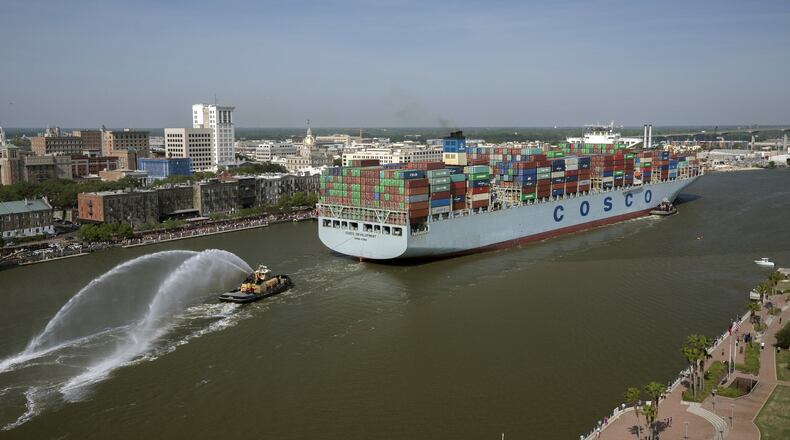Georgia's Savannah port posted another record fiscal year for container traffic for the 12 months ending in June, a signal of economic resiliency despite continued global trade tensions.
The Georgia Ports Authority said on Tuesday that container traffic hit a record 4.5 million, 20-foot equivalent units from July 2018 through June, up 7.3 percent from the prior fiscal year. Automotive and machinery units shipped through the state’s Brunswick port were up 4 percent during that time.
Georgia’s inland and coastal ports are vital cogs in the state’s economy, and serve as canaries in the global economic coal mine. The volume of cargo that flows in and out of the Savannah and Brunswick harbors are bellwethers of U.S. demand for imports and of the appetite abroad for Georgia-grown or manufactured products.
The ports maintained their respective shipping growth despite Washington and Beijing exchanging tariff salvos and amid other signals of slowing global demand. Savannah reported growth in part from continued economic growth and from capturing market share from other East Coast rivals.
Many forecasters have attributed Savannah’s sustained growth to shippers and retailers attempting to get products to market before the enactment of costly tariffs.
“The economy has held stronger than people anticipated,” Georgia Ports Authority Executive Director Griff Lynch said. “This is not about staying ahead of the tariffs; this is a sign of a good, strong economy.”
Georgia is a southeastern hub for e-commerce and traditional retail distribution facilities. Warehouses for retailers such as Amazon, Tory Burch and the parent company of Calvin Klein dot the metro Atlanta area.
The Atlanta region boasts a rail network and freeway system that provide ready access to the coast. A recent study by the University of Georgia found maritime trade accounts for $44 billion of the state’s gross domestic product and the ports directly or indirectly touch more than 439,000 jobs.
Warehouse and logistics jobs in metro Atlanta soared by about 25 percent from 2014 to 2018, greater than the 18.8 percent national average over that span, according to analysis by real estate services firm CBRE.
Metro Atlanta has doubled in population over the past three decades and that growth will only continue, meaning demand for goods and services from consumers and businesses will grow, said CBRE divisional director of research Dan Wagner.
Developers have built tens of millions of new square feet of warehouse space to handle demand, yet vacancy remains tight.
A large percentage of the containers that move in and out of Savannah go through warehouses on metro Atlanta’s southside, said Toby Jorgensen, an associate director of research for CBRE. The south Atlanta industrial submarket has seen 38 million square feet of net absorption of space over the past five years.
“No question a lot of the port activity is driving that,” he said.
The Savannah port also saw substantial growth in shipping by rail. In 2018, the ports authority launched its Mason Mega Rail Terminal, a sprawling new rail yard designed to improve the Savannah terminal's connection to the main CSX and Norfolk Southern rail networks. That project is about 40 percent complete.
Will McKnight, chairman of the ports authority board, said the Mason project will ultimately allow the port to build nearly 2-mile-long trains on-site and dramatically reduce the time for products arriving in Savannah to reach Nashville, Memphis and Chicago by rail. The Mason terminal will open in phases with full completion expected late next year.
Another critical project — the deepening of the Savannah River's inner harbor — begins soon.
Lynch said a contract to deepen the inner harbor from 42 to 47 feet could start in September. The nearly $1 billion project, arguably the state’s largest-ever economic development project, is slated to be completed by early 2022. It will allow the Savannah harbor to handle ever-larger ships plying through the expanded Panama Canal.
Industrial developer John Porter is building the Savannah Port Logistics Center in Pooler. The nearly 200-acre campus will include more than 2.3 million square feet of warehouse space for export companies in two buildings.
The first building is expected to open later this year, with the second scheduled for 2020. Both are already leased.
Most of Porter’s future tenants produce plastic resins for overseas markets. The manufacturers create high-paying jobs, and the 300 to 400 jobs within the facilities Porter is building will pay above average wages as well.
“The growth they are going to see in the coming years will continue,” he said. “It’s not going to stop.”
Why it matters
Georgia’s inland and coastal ports are vital cogs in the state’s economy, and in some ways canaries in the global economic coal mine. The volume of cargo flowing through Savannah and Brunswick signal consumer demand for imports and of the appetite abroad for Georgia grown or manufactured products. Many economists fear trade tension with China and other nations has slowed economic growth. A recent study by the University of Georgia found maritime trade accounts for $44 billion of the state’s gross domestic product and the ports directly or indirectly touch more than 439,000 jobs.
About the Author
Keep Reading
The Latest
Featured




